HOME | ABOUT US | MEDIA KIT | CONTACT US | INQUIRE
HOME | ABOUT US | MEDIA KIT | CONTACT US | INQUIRE
Below are the top 10 companies in the Ingram’s 2019 Corporate Report 100.
For an overall perspective of the top 100, click here. To view winners 11-100, click here.

(l-r) Aimee Clardy, Vice President-Finance; Jason Yeager, Chief Operating Officer; Jeff Auslander, Chief Executive Officer; Casey Schirk, Chief Revenue Officer.
NUMBER ONE
Dynamic Logistix (1st Year)
Growth: 2,585.46%
Average Annual Growth Rate: 861.82%
Gross Revenue: 2018: $54,353,748 2015: $2,024,003
Full-time employees: 47
If you’re in the third-party logistics-provider space and you’re going up against Dynamic Logistix, a bit of advice: Buckle up. The company founded in 2012 attributes its growth to embrace of technology and getting the right people on board. Working in virtually every aspect of third-party logistics—rail, over-the-road trucking with full and less-than-truckload shipments, refrigerated, construction and flatbed—the company built its portfolio offering model around embracing technology to fuel a culture of service innovation. Let Jeff Auslander, CEO and managing partner, explain: “The customer side is turning over. If you don’t have the technology, the visibility, the transportation-management software, and the reporting that all the other departments enjoy inside your company, you’re probably going to start looking for companies that do those things well. That’s what we do—that’s why we are called Dynamic.” United by a goal of “boldly changing logistics management, one client at a time,” Dynamic seeks to be a disruptor in a sector that Auslander believes is ripe for new-age solutions, “by focusing on providing 21st century shipping solutions on the clients side and being deliberate about it.” Company executives today, from Millennials to GenX to Baby Boomers, expect you to have more tech, more visibility, better execution and accountability.” The ‘right people’ part is where another differentiation lies. When it comes to people, Auslander said, “the biggest thing we look for is people who are competitors. If someone has a competitive drive—and we do personality tests and interviews to figure that out, those are the people we want. People just looking for a job, they’re not for Dynamic.” That’s not just an HR spin; it’s strategic. “This is for someone who wants to grow individually, with the company, and continue to grow and succeed every year; it’s not for the faint of heart,” Auslander says. “We are very communicative and transparent about how each person and group is contributing to success. We’re competing with ourselves, and to make sure our company and clients are being successful as well.” Some of that talent has experience in college athletics, some are just competitive by nature. But collectively, he says, “they don’t take losing well. They want to win for their clients, carriers, and their team.” Stoking that fire is a career path strategy that rewards going above and beyond and demonstrating what Auslander likes to call organized urgency. “There’s always a sense of it, but not just ad hoc hustle, it’s urgency that is well-thought-out and well-executed,” he says. A final piece of the success matrix is tied to the geography of third-party logistics. Being in Kansas City means you have the ability to open early to take care of East Coast clients, he says, and by working past 5 p.m., to address the West Coast. But there’s more to it, and that ties in with those competitive souls Auslander seeks to hire. “The makeup of a Kansas Citian is a perfect mix of hard work, humility, kindness and intelligence,” says Auslander, a native of the area who went to KU and earned his MBA from Baker University. “There are just smart, good people here who work hard and get the job done. There’s a Midwest mentality, and I don’t think a town represents it more than Kansas City does.”
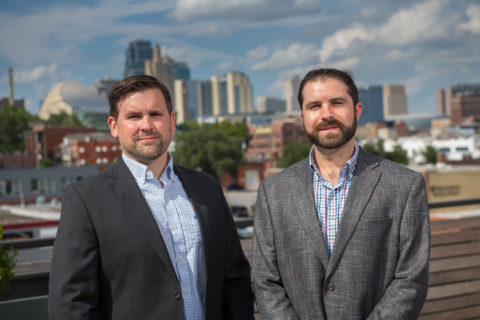
(l-r) (l-r) Ben Galati, Executive Director; Brian Bloss, Managing Director. Not pictured: Ben Bolan, President.
NUMBER TWO
Sethmar Transportation (1st Year)
Gross Revenue: 2018: $9,499,043 2015: $398,462
Growth: 2283.93%
Average Annual Growth Rate: 761.31%
Full-time employees: 22
Most fast-growth companies share a common trait: They tend to be young and scaling. Sethmar Transportation, however, demonstrates that fresh approaches to long-standing operations can infuse new vigor in a company. Formerly owned by an individual who was retiring, it was acquired by three investor/operators who relocated it from Oregon to Overland Park. “We wanted to acquire an existing company,” one with an established credit history, says managing director Brian Bloss. “It allowed us to start doing business immediately without having to use a credit line.” A combined half-century of experience with its employees and a proprietary software platform have been a key elements in its growth. In addition, Bloss says, “we have little overhead and are privately owned, which allows us to adjust to current market conditions quickly.” Relocating to an emerging center of excellence in logistics has also been important. “Freight has to move, no matter what the state of the economy is,” Bloss says.
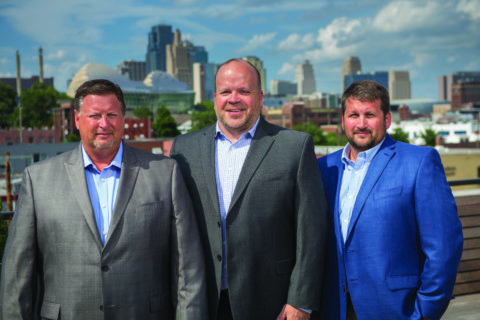
(l-r) Brian Harris, President; Ervin O’Neal, Chief Financial Officer;
Keith Ewing, Project Manager.
NUMBER THREE
Jayger Construction Group (1st Year)
Gross Revenue: 2018: $11,822,105 2015: $749,923
Growth: 1387.20%
Average Annual Growth Rate: 462.40%
Full-time employees: 9
At Jayger Construction Group, says owner Brian Harris, “we have expanded our marketing strategy geographically to include the entire U.S., plus we have diversified our marketing to include retail, medical, restaurants, and hospitality.” Bigger reach, broader
service lines. Fast growth can be that simple. “Having experience in diverse construction disciplines allows us to pursue a wide variety of projects and bring a wide variety of experience to the table for our clients in design-build or plan and spec projects,” Harris says, but they also take on projects that “are not always easy. We pride ourselves on taking the time to explore new areas of construction to increase our market share.” Maintaining that new scale will be another test in a skilled-labor market that he believes is shrinking. “We have found out it takes a little more management of a project to ensure things are progressing on schedule,” he says, adding, hopefully: “Eventually, things will change and the skilled labor will catch up.”
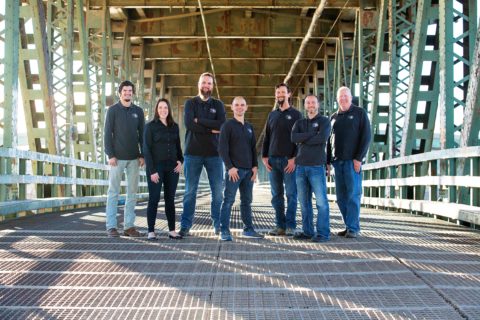
(l-r) Cody Duroso, Field Manager; Jillian Mitchell, Operations/Controller;
Travis Thonen, CEO/Founder; Michael Mitchell, COO; Fred Dohogne, Lead Estimator; Raymond Love, Lead Estimator; Mike Thomas, General Foreman.
NUMBER FOUR
Midwest Comfort Homes (1st Year)
Gross Revenue: 2018: $3,545,028 2015: $380,069
Growth: 832.73%
Average Annual Growth Rate: 277.58%
Full-time employees: 7
Decades later, Travis Tholen remembers the fire that left his family’s home in ruins. For a young boy, it was as much life-affirming as life-changing. “Even after a tragedy, you can achieve a great goal in life and help others,” he says. A career in construction ran into the industry contraction of 2009-10, and he drew on those memories to envision a new niche enterprise. “Not chasing the ambulance, so to speak, like all of the other restoration contractors in the area,” has been a differentiator to fuel growth, he says. In a saturated arena of dishonest contractors, the playing field is not level for consumers. “The customer never knows there is an issue until it’s too late, and they get a subpar finished project or owe the contractor out of pocket.” Another growth factor came after aligning with UMKC’s Small Business Development Center and Scale Up Kansas City. “They helped me understand just what to focus on and how it was indeed an eye-opening moment in my business.” His advice to other fast-track companies? “Be patient and bold, always keep learning.”

(l-r) Kilee and Soren Nickels, Owners.
NUMBER FIVE
Nickel & Suede (1st Year)
Gross Revenue: 2018: $4,775,035 2015: $514,737
Growth: 827.67%
Average Annual Growth Rate: 275.89%
Full-time employees: 27
Leather. Earrings. Putting the two together has proved solid gold for this Liberty company first envisioned by Kilee Nickels, who founded it with husband Soren in 2014. The initial goal was to create a simple pair of lightweight, statement earrings. Easier said than done with a market long-trained in the allure of metals. But if the company could get women to step out of old comfort zones with an entirely new look, the Nickelses thought, there was a chance. Stylish, lightweight and comfortable, the first offerings from a 300-square-foot basement workshop quickly caught on. “Word-of-mouth free marketing allowed our product to essentially sell itself: an entrepreneur’s dream,” Kilee says. Now operating in 15,000 square feet of space, with a flagship store in the works, they are shipping to hundreds of customers a day, sometimes more, so prospects for continued growth look promising. New looks helped women take more chances to improve their lives, she said, and “this is the real special sauce behind our customer enthusiasm and loyalty.”
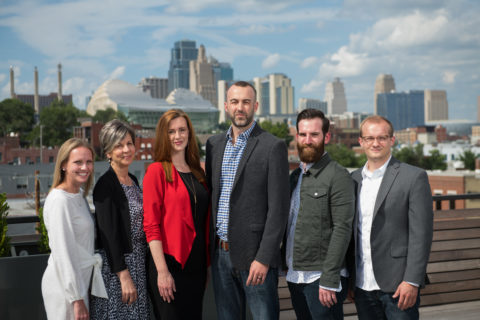
(l-r) Jackie Romero, Account Service Director; Lisa Anderson, Controller; Shelby Mathews, Creative Director; Justin Watkins, CEO; Greg Vodicka, Brand Strategy Director; Matt Seeley, Director of Integrated Marketing.
NUMBER SIX
Native Digital (1st Year)
Gross Revenue: 2018: $2,012,782 2015: $223,469
Growth: 800.70%
Average Annual Growth Rate: 266.90%
Full-time employees: 13
Yes, that’s the Richard Branson gazing back at you from Native Digital’s roster of clients Web page. That should tell you something about the level that founder/CEO Justin Watkins is playing at with this Midtown-based marketing firm, which is all about helping clients create, organize and manage online content, branding strategies and creative processes. In 2014, Watkins says, “the world certainly didn’t need another marketing firm. At the same time, I saw top talent leaving KC for better opportunities on the coasts and clients who were underserved by agencies operating with dated business models.” He won on his bet that a new model could attract top-tier talent, keep them here, and become a valued partner for brands. “It’s still very much a work-in-progress but we’re seeing positive signs that we might be on to something,” Watkins says. The big differentiator that helped get out of start-up mode, he says: “Referrals. We made sure to deliver high value and make our clients’ lives easier. We never asked for referrals but this is Kansas City—people talk.”
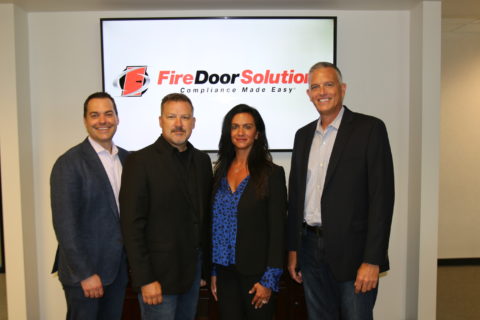
(l-r) Miles Franz, Executive Vice President of Sales; Jeff Perry, Chief Executive Officer and Executive Director; Vanessa Perry, Partner; Jeff Crank, Vice President of Sales.
NUMBER SEVEN
Fire Door Solutions (1st Year)
Gross Revenue: 2018: $21,298,779 2015: $2,985,338
Growth: 635.62%
Average Annual Growth Rate: 211.87%
Full-time employees: 4
Right space, right time: When federal authorities ordered increased compliance with life-safety building issues in health-care facilities several years ago, Fire Door Solutions was almost uniquely qualified to capitalize. Jeff Perry founded the company in 2012, the first year of those compliance orders, and Fire Door has developed customized processes and procedures to successfully inspect, repair, re-label and formally report on key life-safety issues around fire doors, dampers and fire-stopping. As an enterprise in an emerging market, its levels of service have been the single largest growth determinant, and in the span of seven years, it has become a national leader in compliance services for passive fire-protection systems. The Stilwell-based outfit now supports clients in all 50 states, and has more than 100 employees. A lot of companies will rightfully boast of providing unparalleled quality, but Perry goes them one better by providing “irrational service, knowing that others’ lives depend on our lives” to lighten the burden for customers.
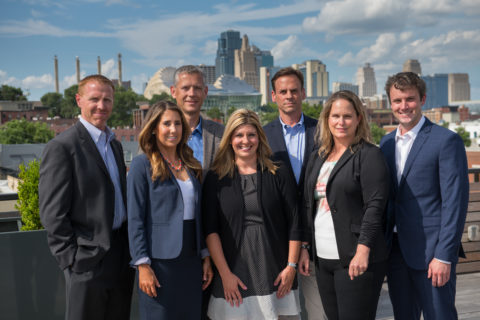
(l-r) Nick Krier, VP-Field Operations; Melanie Osterhaus, VP-Marketing;
Raynard Brown, President; Jenna Henderson, VP-HR; Eric Lauterbach; Director of Purchasing, Tamara Chambers; Director of Finance; Kerry Bowen, VP-Operations.
NUMBER EIGHT
Inspired Homes (1st Year)
Gross Revenue: 2018: $30,311,564 2015: $4,403,894
Growth: 588.29%
Average Annual Growth Rate: 196.10%
Full-time employees: 18
When it comes to building someone’s home, affordability and value are of paramount importance to buyers. But inefficiencies inherent in a fragmented home-construction market in Kansas City, builders say, too often result in the need for many contractors to work at the higher end of the pricing range. Result? New homes in Kansas City have long had higher price points that those in peer markets of the Midwest. In 2014, the vision behind Inspired Homes set out to address that by rethinking the construction process, using deeper, more reliable consumer data to identify potential cost-savings, and getting those homes produced at scale in the mid-$200,000s to $400,00 price range. As the numbers show, they were onto something. At the core of Inspired Homes’ success, company officials say is the technology to inform and streamline the design and build phases for the eight floor plans it offers. It then backs all of that up with a 10-year structural warranty and has no site-condition fees.

Cristil Miranda, Founder and Owner.
NUMBER NINE
Platinum Painting (1st Year)
Gross Revenue: 2018: $1,416,253 2015: $218,271
Growth: 548.85%
Average Annual Growth Rate: 182.95%
Full-time employees: 6
A true entrepreneur senses a need and sets out to meet it—and sometimes, the need is personal. For Cristil Miranda, Platinum Painting started as a backup plan six years ago, when the non-profit she was working for saw access to federal funding whither. “I knew that it was a matter of time before I would have to lay myself off,” she recalls. She took stock of her experience as operations director, working with contractors, local utilities, city officials and schools. Then she drew on her work in hiring, HR policy, managing business insurance and employee benefits, and twinned it with her husband’s background as a painter. “I strapped myself with self-confidence, added determination to succeed and lots of hard work,” she says. The key to getting things jump-started? “Investing in marketing is key when you have a great service to provide,” Miranda says. “Definitely, being a woman in the male-dominated environment is a challenge. But in turn being a woman ensures promises made are kept and being a detailed person is a must.”
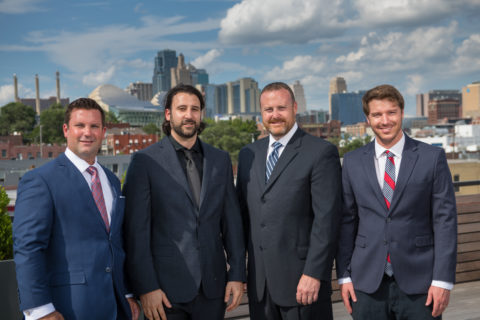
(l-r) Tanner Morton, Managing Partner; Conner Morton, Partner;
Jason Schnellbacher, Co-Founder; Tyler Muxlow, Outside Sales.
NUMBER TEN
Prineta (2nd Year)
Gross Revenue: 2018: $1,684,892 2015: $277,750
Growth: 506.62%
Average Annual Growth Rate: 168.87%
Full-time employees: 5
Jason Schnellbacher and Tanner Morton saw an opportunity, acted on it—and found a better one. They starting Prineta in 2009 to process credit-card payments for retailers. “There were low barriers to entry in that space, and a price war from an economic perspective—it was very competitive, and the margins were very small,” Schnellbacher says. “Twenty dollars a month didn’t add up too fast.” When a client suggested checking into ATM servicing, Schnellbacher had his doubts—in an emerging world of mobile pay, who would still eat a $3 fee to use an ATM? Turns out, lots of folks. So they pivoted the model to ATMs, and “to our surprise, it got pretty good usage,” he says. “We still see it as the same company,” Schnellbacher says. “We just changed the focus on where we spent time and energy. It’s consistent with our original plan, because the ATM business is residual, as well.” Debt-free, investing all proceeds back into the business, they have ridden the snowball effect to build a national network to service increasing numbers of ATMs.